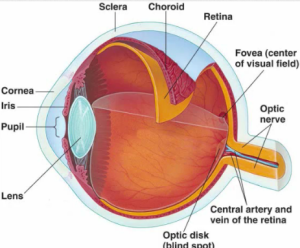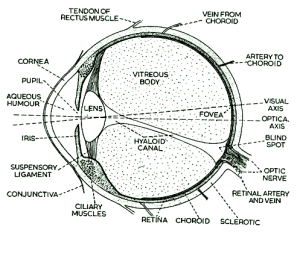The size of the eye is around one inch in diameter, but it performs a key function i.e. eyesight. Among all the five senses, sense of sight is one of the ways that one uses to collect details about the surrounding environment.
The eye can be defined with the help of a camera. In a camera, lens focuses on the light that enters inside and then the light is gathered and transformed into a picture. Similarly, the eyes-lens focuses on the light that enters, and then after gathering the light it transforms into an image. As a camera makes use of film to make a picture the eye uses specialized layer of cells known as ‘retina’ to make an image.
The various parts of the eye that form the complete anatomy of the eye are as follows:
- Sclera: Sclera is like a white leather tissue. The white part of the eye is called as ‘sclera’ but it is only the front portion, it also spreads around the eye. For example, like an egg is surrounded by the shell of the egg and thereby it gives a shape. In the same manner the eye is surrounded by the sclera giving the eye its form. Muscles called ‘extraocular muscles’ are joined with the sclera which helps the eye in moving in all the direction.
- Extraocular muscles: There are 6 extraocular muscles which are attached to both the eyes. It helps in moving the eye in all the directions i.e. right, left, down, up and diagonally.
- Posterior Chamber: This posterior chamber is located in the rear of the iris but in front of the lens. It is a space filled with fluid known as ‘aqueous humor’. This fluid helps in nourishing the lens and cornea.
- Eyelashes and Eyelids: Eyelashes helps in filtering the foreign particles like dust. Also it helps in preventing all such foreign particles from getting inside the eyes. The eyelids whereas helps in protecting the eye from foreign particles like dust, dirt and dazzling light that will be damaging to the eye. When a person blinks the eyelids helps in spreading the tears over the exterior of the eye, and in turn helping the eyes to remain moist and calm.
- Lens: Lens is situated right behind the iris and pupil. It is a flexible and clear structure and is surrounded by a loop of muscular tissues known as ciliar body. Together, i.e. ciliary body and lens help in controlling the focus of light as it passes all the way through the eye.
- Conjunctiva: It is a clear and thin cover of skin that covers the front portion of the eye which includes sclera and interior of the eyelids. Conjunctiva helps in keeping the bacteria and foreign particles from entering behind the eyes.
- Vitreous Cavity: It is situated in front portion of the retina and behind the lens. It is filled with fluid similar to gel which is known as vitreous humor. This fluid helps in maintaining the form of the eye.
- Cornea: Cornea is a cover in the front and middle of the eye. It is a clear cover, so clear that one may not know its presence. It is situated right in front of iris, the colored portion of the eye. The important function of cornea is that it helps to focus light when it gets into the eye. Also those who use contact lenses, the lens are fixed on this cornea.
- Retina, Macula and Choroid: Retina helps in creating an image. For this a specialized cover of cells helps in converting light signal into nerve signal and when these light signals are changed into nerve signal, signals are sent by the retina to the optic nerve which further passes these signals to the brain. Brain further helps in processing the image. Macula is situated in the middle portion of the retina which is in charge of giving a sharp central vision. Choroid is a cover of tissues that divides the sclera and retina. It is usually made of blood vessels and helps in nourishing the retina.
- Anterior Chamber: It is a chamber filled with fluid called aqueous humor which helps in nourishing the cornea and lens. It is situated in front of the iris and right behind the cornea.
- Orbit: Orbit is the socket of eye. Different parts like the temple, forehead, cheekbones and side part of the nose form the orbit. The eye is padded by layer of fat inside the orbit. The orbit also has glands known as ‘lacrimal gland’ which is situated below the external part of the upper eyelid. From these glands tears are produced that helps in lubricating and moistening the eyes. Also it helps in flushing away foreign particles that could come into the eye.
- Anterior Chamber Angle and Trabecular Meshwork: Both are situated at the union of cornea and iris. The trabecular meshwork is the place from where aqueous humor drains out. If it does not correctly drain out then it can build stress inside the eye which in turn will cause injure to the optic nerve leading to glaucoma i.e. loss of vision.
- Optic Nerve: It is a bunch of more than one million nerve fibers. It helps to transmit nerve signals from eye to the brain.
Human Eye FPS
Frame rate is the frequency or rate at which an imaging device creates consecutive images known as frames. The term is also applicable to computer graphics, motion capture systems, smartphone cameras, video cameras, film cameras etc.. Frame rate is expressed in terms of frames per second (FPS)
The human eye can process 10 to 12 distinct images per second. The visual cortex in the eye holds on to the picture of one image for 1/15th of a second, so if there is another picture that is received during that period, there is an illusion of continuity, which gives you a sequence of still pictures, giving the feeling that you are watching it in a motion sequence.
Diagram of the Eye
Here are parts of the human eye with its parts

